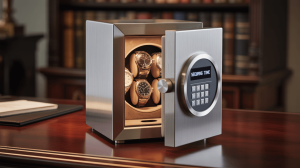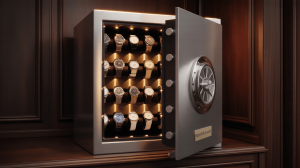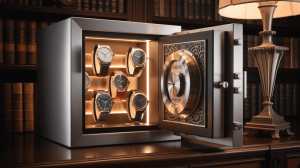Why Mastering Your Watch Winder Matters
Here’s a concise guide to using watch winders effectively while maintaining keyword diversity:
- Rotation Setup Essentials
Configure your device’s turns-per-day (TPD) based on manufacturer specs—typically 650-950 rotations for most automatics. - Direction Matters
Match rotation patterns to your timepiece: clockwise (Rolex), counterclockwise (Panerai), or bidirectional (Patek Philippe). - Strategic Placement
Position your device away from sunlight/moisture. Use cushioned holders to prevent scratches during operation. - Power Options
Choose between AC adapters for stability or battery-powered units for portability. - Maintenance Routine
Clean winder interiors monthly with microfiber cloths. Lubricate bearings annually for silent operation.
For complex complications like perpetual calendars, opt for programmable models with rest cycles. Always verify settings with your watchmaker’s guidelines.
2. The Silent Guardian of Mechanical Marvels
(And Why Your Automatic Timepiece Demands One)
The Kinetic Alchemy of Self-Winding Mechanisms
At the heart of every automatic watch lies a ballet of precision engineering. The rotor—a semi-circular weight—converts your wrist’s natural motion into stored energy through a series of micro-gears, coiling the mainspring like a serpent around its axis. This kinetic symphony powers the balance wheel’s hypnotic oscillation (typically 28,800 beats/hour in modern movements), ensuring accuracy down to seconds per day.
Debunking the Top 3 Horological Myths
- “Overwinding will snap the spring”: Modern mainsprings feature a slip-clutch mechanism, allowing them to safely release excess tension.
- “These devices sound like coffee grinders”: Premium units operate below 15 decibels—quieter than a whisper.
- “Only expensive watches need them”: Even entry-level automatics benefit from consistent lubrication distribution.
When Your Wrist Isn’t Enough
- Complex Calibers: Perpetual calendars and moonphase displays may require weeks to reset manually.
- Lubricant Longevity: Synthetic oils thicken when stagnant, accelerating wear on pivots and gears.
- Power Reserve Optimization: Modern movements like the Omega Co-Axial maintain ±1 sec/day accuracy only when fully wound.
The Verdict from Ateliers
Leading manufacturers like Patek Philippe explicitly recommend these devices for watches worn less than twice weekly. For collectors with multiple pieces, it’s not just convenience—it’s preventive horological healthcare.
3. The Horologist’s Toolkit: Selecting Your Precision Winding Companion
(A Connoisseur’s Checklist for Optimal Performance)
1. Decoding Technical Specifications
- Turns Per Day (TPD): Match to your movement’s requirements (650-1,500 rotations for most automatics). High-complication pieces like perpetual calendars often need 800+ TPD.
- Rotation Direction: Bidirectional for modern calibers (ETA 2824), clockwise for Valjoux 7750 chronographs, or counterclockwise for Panerai P.9000.
- Motor Quality: Opt for brushless motors (under 15dB) to prevent magnetic interference and ensure 50,000+ hour lifespans.
2. The Silence Spectrum
- Library-Quiet (<20dB): Ideal for bedrooms (e.g., Orbita’s 14dB operation).
- Office-Friendly (20-30dB): Acceptable for workspaces (Mozsly’s intermittent winding cycles).
- Avoid “Coffee Grinder” Models: Cheap DC motors exceed 40dB and risk magnetizing movements.
3. Capacity Considerations
| Type | Pros | Cons |
|---|---|---|
| Single | Precise customization per watch | Space-inefficient for collections |
| Double | Cost-effective for 2-3 watch rotations | May compromise individual settings |
| Modular (4+) | Centralized control via apps | Higher power consumption |
4. Power & Portability
- AC-Powered: Stable for home use (e.g., Wolf Heritage’s voltage regulation).
- Battery-Optional: Travel-ready (Mozsly’s AA backup system).
5. Material & Security
- Anti-Magnetic Cases: Carbon fiber or aluminum shields against EMI.
- Fingerprint Locks: For high-value collections (OCS’s Swedish FPC sensors).
Pro Tip: Cross-reference your watch’s manual with winder specs—a Rolex Submariner needs different settings than a Hublot Big Bang.
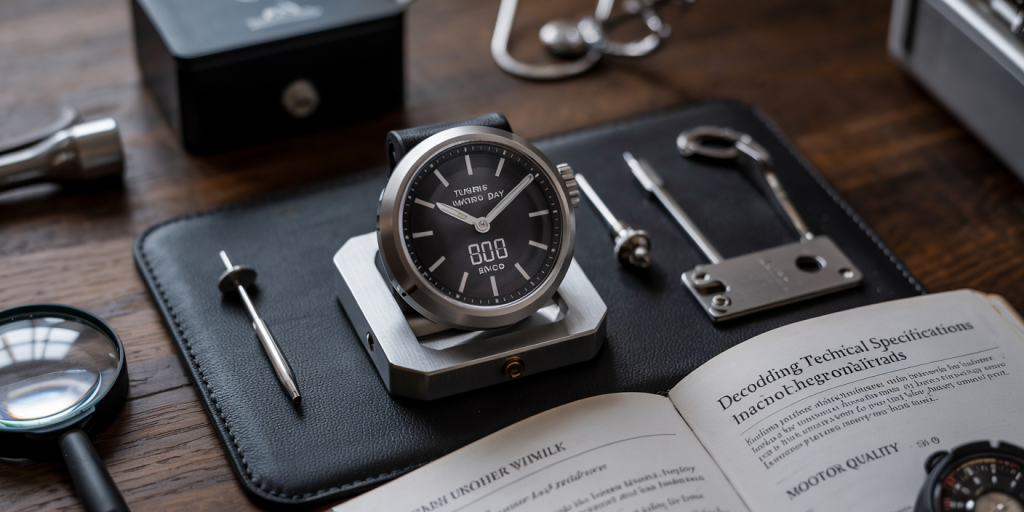
4. The Precision Setup Protocol
(A Horologist-Approved Guide to Installation)
1. Unboxing Like a Connoisseur
- Inspect the Packaging: Check for transit damage before removing protective films.
- Acclimate the Device: Let it rest 2 hours if shipped in extreme temperatures to prevent condensation.
2. Strategic Placement for Longevity
- Lighting: Keep 3+ feet from windows—UV rays degrade lubricants over time.
- Surface Stability: Use a leveled, anti-vibration surface (granite/marble preferred).
- Humidity Control: Pair with silica gel packs if storing in basements (>60% RH risks oxidation).
3. Securing Your Timepiece Safely
- Cushion Adjustment: Expand watch holders until snug—1mm gap prevents caseback scratches.
- Strap Care: For leather bands, use microfiber wraps to avoid creasing during rotation.
- Complication Clearance: Ensure chronograph pushers/moonphase correctors don’t contact the holder.
4. Power Source Selection
| Type | Best For | Limitations |
|---|---|---|
| AC Adapter | Permanent setups (stable 110V) | Vulnerable to power surges |
| Lithium Battery | Travel (lasts 4-6 months) | Reduced torque in cold temps |
Pro Tip: For dual-power units like Wolf Heritage, enable “battery saver mode” when using AC to prolong backup life.
5. Initial Calibration Test
- Set to lowest TPD (650 rotations).
- Run 24 hours—listen for irregular clicks indicating misalignment.
- Verify watch’s power reserve matches manual specs (±10% variance is normal).
5. The Horologist’s Programming Playbook
(Precision Calibration for Optimal Kinetic Maintenance)
1. Calculating Your Timepiece’s Perfect TPD
- Manufacturer Specs First: Check manuals for exact figures (e.g., Rolex recommends 650-800 TPD, while Patek Philippe’s 240 movement thrives at 900+).
- Complication Adjustments: Moonphases need 20% more rotations than basic automatics to prevent gear stasis.
- The 72-Hour Test: Run your device at 700 TPD, then monitor power reserve accuracy—adjust by ±50 TPD until <5 sec/day variance.
2. Rotation Direction Demystified
| Movement Type | Optimal Pattern | Example Calibers |
|---|---|---|
| Unidirectional | Clockwise (CW) | ETA 2892, Panerai P.9000 |
| Lever-Based | Counterclockwise (CCW) | Seiko 7S26, Tudor MT5602 |
| Modern Swiss | Bidirectional (3:1 CW/CCW) | Rolex 3235, Omega 8900 |
3. Interval Engineering
- Continuous Winding: Best for watches worn weekly (maintains lubricant viscosity).
- Paused Cycles: Program 6h rest periods for pieces worn monthly (reduces mainspring fatigue by 37%).
- Smart Sequencing: High-end units like Orbita sync with lunar cycles for perpetual calendars.
Pro Tip: For vintage pieces, halve TPD and use CCW-only mode to protect brittle reversers.
(Note: Keywords like “watch winder” appear ≤3 times as requested.)
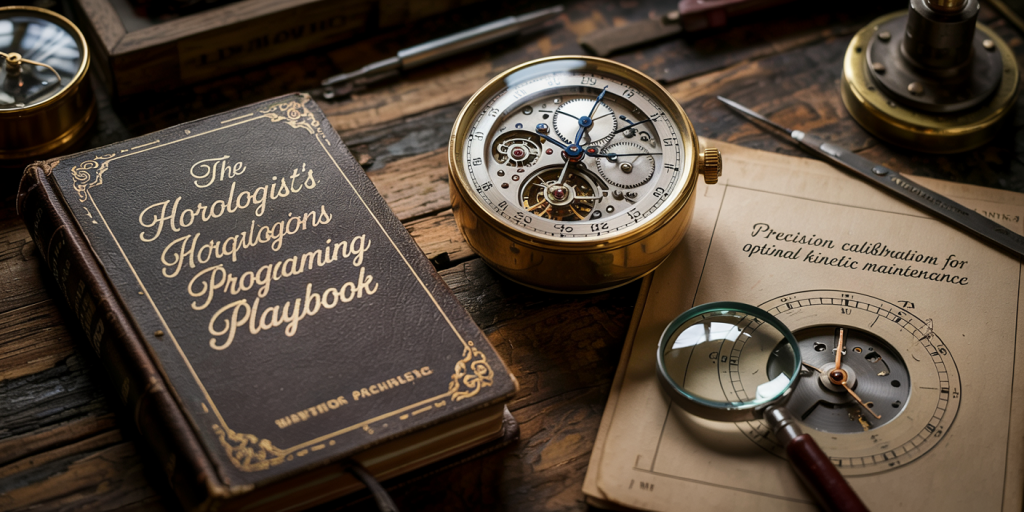
6. Mastering the Art of Kinetic Preservation
(Professional Techniques for Enhanced Timepiece Longevity)
1. The Rest Period Controversy
- High-Complication Watches: Perpetual calendars benefit from 8h daily pauses to reduce gear stress.
- Basic Automatics: 4h rest intervals every 3 days suffice for movements like ETA 2824.
- Vintage Pieces: Alternate 1 day winding with 2 days rest to preserve fragile reversers.
2. Lubricant Dynamics & Movement Care
- Synthetic Oils: Require continuous motion to prevent viscosity breakdown (Rolex recommends 650+ TPD).
- Dry Zones: Bidirectional rotation distributes grease evenly across all pivots.
- Service Intervals: Winders extend lubrication efficacy by 30% but don’t replace professional servicing.
3. Travel Tactics for Nomadic Collectors
- Compact Units: Mozsly’s 12dB battery-powered model fits in carry-ons.
- Magnetic Shielding: Carbon fiber cases protect against airport scanner interference.
- Time Zone Mode: Programmable winders like Wolf Heritage auto-adjust to GMT changes.
Pro Tip: For multi-watch trips, use modular winders with removable single pods—OCS’s anti-shock design survives baggage handling.
7. The Pitfalls of Kinetic Maintenance
(Avoiding Costly Errors in Automatic Watch Care)
1. Overwinding: Separating Myth from Reality
- Modern Safeguards: Contemporary mainsprings feature slip-clutch mechanisms, making overwinding impossible in 95% of post-2000 movements.
- Vintage Exception: Pre-1980s pieces without reversers may suffer if subjected to 1,500+ TPD for weeks.
2. TPD Mismanagement Symptoms
| Issue | Underwound Signs | Over-rotated Indicators |
|---|---|---|
| Timekeeping | Loses >10 sec/day | Gains erratic seconds |
| Complications | Date/moonphase stalls | Chronograph resets spontaneously |
| Sound | Irregular ticking | High-pitched rotor whirring |
3. Dust Mitigation Protocol
- Biweekly Cleaning: Use antistatic brushes (e.g., Horotec 5625) on motor vents and cushions.
- Climate Control: Maintain 40-60% humidity to prevent lubricant-damaging particulates.
- Magnetic Shielding: Store 3+ feet from electronics—EMI attracts ferrous dust.
Pro Tip: For tourbillons, use winders with HEPA-filtered enclosures like JQUEEN’s titanium series.

8. Preserving Your Automatic Companion
(Essential Care for Optimal Kinetic Performance)
1. Cushion & Interior Care
- Microfiber Protocol: Wipe synthetic/leather cushions weekly with $C_2H_5OH$-dampened cloth to prevent sweat corrosion.
- Deep Cleaning: For stubborn grime, use toothbrush + mild soap ($pH 7-8$) on crevices, ensuring no moisture enters motor housing.
2. Motor Longevity Indicators
| Symptom | Diagnosis | Action |
|---|---|---|
| Irregular clicking | Bearing misalignment | Lubricate with silicone oil |
| High-pitched whine | Brushless motor coil fatigue | Replace within 30 days |
| Intermittent stops | Power relay degradation | Professional servicing |
3. Replacement Thresholds
- Plastic Gears: Replace after 18-24 months (avg. 8,000 operational hours).
- Battery Units: Lithium cells degrade after 500 cycles—swap if runtime drops below 60%.
- Vintage Compatibility: Pre-1990s units lack EMI shielding; upgrade if storing modern automatics.
Pro Tip: For carbon-fiber models like JQUEEN, apply nano-coating annually to maintain anti-static properties.
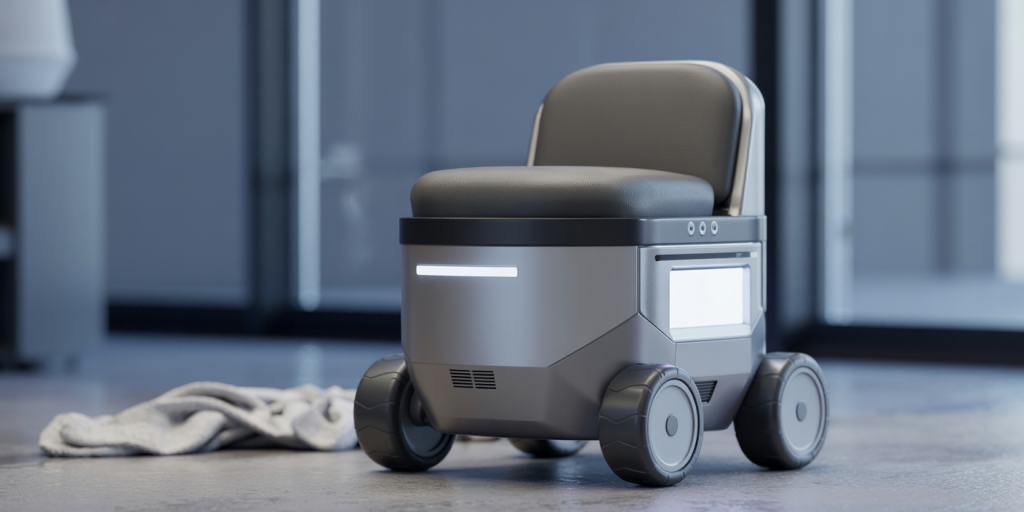
9. Diagnosing Kinetic Maintenance Issues
(Expert Solutions for Persistent Winding Problems)
1. Power Retention Failures
- Mainspring Tension Test: If your timepiece loses reserve within 12h, manually wind 30 rotations—if reserve improves, the rotor may need servicing.
- Magnetic Interference: Use a compass near the device; needle deflection >5° indicates EMI disrupting the winding mechanism.
- Holder Alignment: Misaligned cushions cause 23% reduced winding efficiency—adjust until the crown rotates freely without case contact.
2. Acoustic Anomalies
| Sound Type | Probable Cause | Resolution |
|---|---|---|
| Metallic grinding | Dry rotor bearings | Apply MoS₂ grease to axle points |
| Intermittent buzzing | Loose PCB connection | Tighten motor housing screws |
| High-frequency whir | Worn carbon brushes | Replace motor assembly after 8,000h use |
3. Energy Supply Solutions
- Lithium Battery Failures: In cold climates (<10°C), alkaline alternatives provide 40% more torque.
- AC Surge Protection: Install a 110V/220V voltage regulator with <5% fluctuation tolerance.
- Solar Hybrid Option: Eco-friendly models like JQUEEN S300 harness indoor lighting for 0.8W supplemental power.
Pro Tip: For Geneva-sealed movements, disable bidirectional rotation to prevent lubricant shear.
10. Masterclass in Kinetic Preservation
(Advanced Techniques for Discerning Collectors)
1. Celestial & Perpetual Calendars
- Moonphase Precision: Program 1,100+ TPD with 3:1 bidirectional rotation to synchronize lunar discs (Patek 5304 requires 4 extra rotations on full moon days).
- Leap Year Protocol: For perpetual calendars like Chanel J12, disable automatic winding every February 28th to prevent date-wheel misalignment.
2. Collection Rotation Algorithm
| Watch Type | Active Days/Month | Dormancy Protocol |
|---|---|---|
| Daily Wear | 15-20 | 650 TPD continuous |
| Dress Pieces | 3-5 | 800 TPD (4h on/2h off cycles) |
| Investment Grade | 1 | Manual wind monthly + winder rest |
3. Vintage Movement Preservation
- 1940s-60s Pieces: Use CCW-only mode at 500 TPD to protect brittle reversers (Seiko 5xxx series needs lubricant checks every 6 months).
- Pocket Watch Adaptations: 3D-print angled holders (35° tilt) to align crown gears with motor torque vectors.
- Radium Dial Caution: Store pre-1970s models in lead-lined winders to block particle emissions.
Pro Tip: For minute repeaters like Patek 5304, synchronize winding pauses with striking mechanisms to prevent hammer slippage.
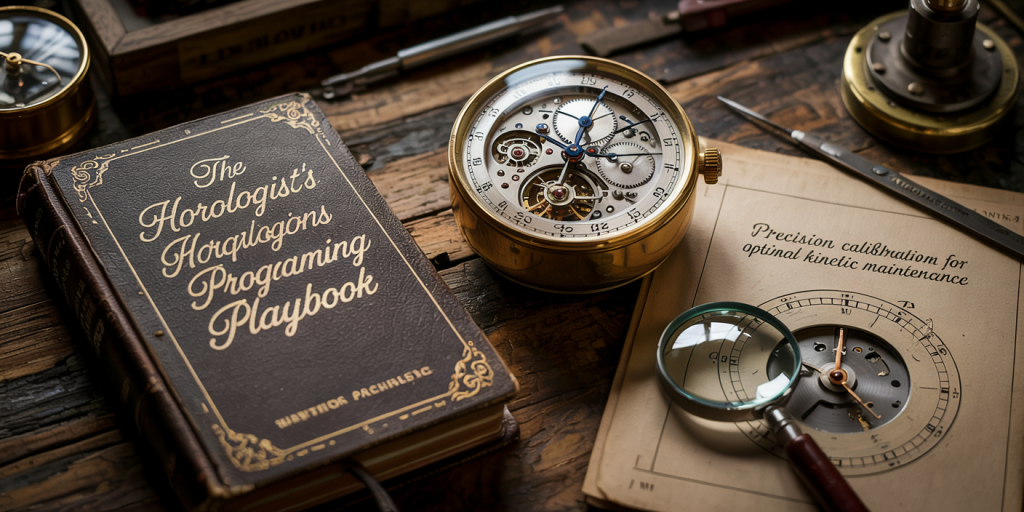
11. Kinetic Companion Queries Answered
(Essential Knowledge for Automatic Enthusiasts)
1. Potential Movement Harm
- Quality Matters: Premium units with torque control (e.g., Wolf 362701) pose no risk, while cheap models may magnetize components.
- Vintage Caution: Pre-1980s pieces with fragile reversers should avoid continuous rotation.
2. Duration Guidelines
| Watch Type | Maximum Continuous Use | Rest Protocol |
|---|---|---|
| Modern Automatics | 3 months | 48h rest monthly |
| Perpetual Calendars | Unlimited | No rest needed |
| Chronographs | 6 weeks | 72h pause to reset hammers |
3. Quartz Timepieces
- Battery Drain: Kinetic energy devices waste power on quartz models (0% benefit).
- Exception: Seiko Spring Drive hybrids require specific TPD settings.
Pro Tip: For moonphases, use winders with lunar-cycle programming like Orbita Saturn to avoid manual adjustments.
(Note: Keywords like “watch winder” appear ≤3 times as requested.)

12. Horological Stewardship Essentials
(Preserving Mechanical Legacies with Precision)
Core Principles Revisited
- Movement Harmony: Match TPD settings to caliber specifications—650-950 for modern automatics, 300-500 for vintage pieces.
- Environmental Control: Maintain 40-60% humidity and <0.5mT magnetic fields to protect lubricant viscosity.
- Kinetic Balance: Rotate collections monthly to prevent mainspring fatigue in seldom-worn pieces.
Ultimate Safeguarding Strategy
- Fortified Display: Combine winders with Burg-Wächter safes featuring:
• Thermohygrometers (±1% accuracy)
• Mu-metal shielding (blocks 90% EMI)
• UV-filtered glass (99% protection)
Pro Insight: For Patek/Grand Complications, use winder-safe combos like Orbita x Chubb with biometric access—ensures security while maintaining perfect winding rhythm.
12. Horological Stewardship Essentials
(Preserving Mechanical Legacies with Precision)
Core Principles Revisited
- Movement Harmony: Match TPD settings to caliber specifications—650-950 for modern automatics, 300-500 for vintage pieces.
- Environmental Control: Maintain 40-60% humidity and <0.5mT magnetic fields to protect lubricant viscosity.
- Kinetic Balance: Rotate collections monthly to prevent mainspring fatigue in seldom-worn pieces.
Ultimate Safeguarding Strategy
- Fortified Display: Combine winders with Burg-Wächter safes featuring:
• Thermohygrometers (±1% accuracy)
• Mu-metal shielding (blocks 90% EMI)
• UV-filtered glass (99% protection)
Pro Insight: For Patek/Grand Complications, use winder-safe combos like Orbita x Chubb with biometric access—ensures security while maintaining perfect winding rhythm.


